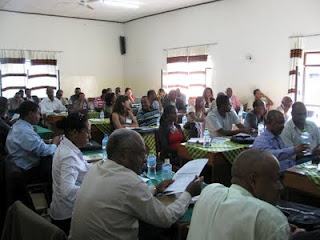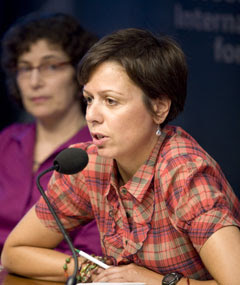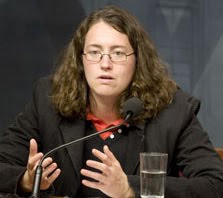Showing posts from category Africa.
-
Alec Crawford on Climate Change and Conflict in Africa and the Middle East
›January 14, 2010 // By Sajid Anwar“Climate change certainly does pose a risk to the world in terms of violent conflict, but there’s a lot of nuance to that argument and a lot of attention and care has to be put into making that case,” says Alec Crawford, project officer at the International Institute for Sustainable Development (IISD) in this video interview with ECSP Director Geoff Dabelko.
According to Crawford, the argument that climate change will lead directly to violent conflict is overly simplistic, but climate could be one of conflict’s many drivers in both Africa and the Middle East. A recent IISD report discusses the potential security challenges of climate change and how to prevent them. -
Eco-Tourism: Kenya’s Development Engine Under Threat
› Africa’s elephants and black rhinos—already at risk—are increasingly threatened as the price of black market ivory rises, global markets contract, and unemployment rates rise. To fight poaching of these tusked animals, Ian Craig, founder of the Lewa Conservancy in Kenya and the brains behind the Northern Rangelands Trust, takes a unique approach to conservation that involves both local community members and high-level government officials, as well as private and public sector investors.
Africa’s elephants and black rhinos—already at risk—are increasingly threatened as the price of black market ivory rises, global markets contract, and unemployment rates rise. To fight poaching of these tusked animals, Ian Craig, founder of the Lewa Conservancy in Kenya and the brains behind the Northern Rangelands Trust, takes a unique approach to conservation that involves both local community members and high-level government officials, as well as private and public sector investors.
In the 1970s the black rhino population was at about 20,000. Less than three decades later, it had fallen to 200. Today, the population is about 600, of which 79 live in the Lewa Conservancy. The vast regions of Kenya covered by the Northern Rangelands Trust and the Lewa Conservancy are difficult to govern, so the conservancies partner with local communities to ensure the security necessary to protect the animals from poachers. By investing in community institutions, the conservancies create long-term sustainability and self-sufficiency.
But why should local communities—often beset by poverty, disease, and hunger—care about saving elephants or rhinoceroses rather than killing them for their tusks or meat? Revenue from tourism can total hundreds of thousands of dollars, especially because of the high cost and exclusive nature of tourism facilities in the area. This money is then injected back into community programs to improve adult literacy, school nutrition, health care, micro-credit, water and irrigation systems, community livestock and agriculture, and forestry and aquaculture.
In some politically volatile areas, the conservancy serves not only as a platform for ecological security, but also as a mediator of disputes. Where livestock theft is rampant, multi-ethnic anti-poaching teams have been able to act as intermediaries. Community elders and other traditional leaders serving on the conservancies’ boards have bi-annual meetings to further intra- and inter-regional cooperation. Along with regular managerial and council meetings, the board meetings set standards for good practices, open dialogue for policymaking and cooperation, and act as a unique platform for communication between different ethnic and regional groups.
Community members understand they have a stake in protecting not only the animals, but in ensuring security and building trust within the country. With its unique combination of local-level engagement, the cooperation and support of the Kenyan Wildlife Service and the national government, and with the resources available to the conservancies as a group, the Lewa Wildlife Conservancy hopes to create a model of conservation that can be used across Africa and in other at-risk regions.
The future is shaky: ivory prices continue to rise, the migration of animals has facilitated poaching, and small arms are abundantly available. However, the new community-focused approach has helped to create positive attitudes that aren’t just about saving animals, but about developing the nation.
Justine Lindemann is program assistant with the Africa Program at the Woodrow Wilson International Center for Scholars.
Photo: Elephants in Lewa Conservancy area, courtesty Flickr user Mara 1 -
Climate Combat? Security Impacts of Climate Change Discussed in Copenhagen
› Leaders from the African Union,the European Union, NATO, and the United Nations have agreed unanimously that climate change threatens international peace and security, and urged that the time for action is now.
Leaders from the African Union,the European Union, NATO, and the United Nations have agreed unanimously that climate change threatens international peace and security, and urged that the time for action is now.
In Copenhagen Tuesday, Anders Fogh Rasmussen, the secretary-general of NATO; Jean Ping, the chairperson of the Commission of the African Union; and Helen Clark, the administrator of the UN Development Programme, were joined by Carl Bildt and Per Stig Møller, foreign ministers of Sweden and Denmark respectively, to take part in a remarkable public panel discussion organized by the Danish Ministry of Foreign Affairs.
The leaders agreed climate change could hold serious implications for international security, both as a “threat multiplier” of existing problems and as the cause of conflict, under certain conditions.
Møller suggested there is evidence that higher temperatures in Africa could be directly linked to increases in conflict. Ping emphasized that African emissions make up only 3.8 per cent of the climate problem, though Africa will likely suffer some of its most serious impacts. Fogh Rasmussen warned of the dangers of territorial disputes over the Arctic as the sea ice recedes. “We need to stop the worst from happening,” said Clark.
While there was broad agreement on the seriousness of the challenge, the participants differed on what should be done. Responding to a question from the audience, Bildt argued that Europe should not necessarily throw open its doors to climate migrants, but that the bloc needed to help countries deal with climate change so people can stay at home. Clark argued that enlightened migration policy could meet two sets of needs: reversing declining populations in the North while providing a destination for unemployed workers from the South.
Fogh Rasmussen said militaries can do much to reduce their use of fossil fuels. He noted that 170 casualties in Afghanistan in 2009 have been associated with the delivery of fuel. There is no contradiction, he argued, between military efficiency and energy efficiency.
However, the real significance of the climate-security event lay not in what these leaders said, but that they were there to say it at all. Not many issues can gather the heads of the AU, NATO, and the UNDP on the same platform, alongside the foreign ministers of Sweden and Denmark. This event proved that climate change has become a core concern of international policymakers.
The only way to tackle global problems, as Ping argued, is to find global solutions. And a clear understanding of the potentially devastating security implications of climate change might be one way to bring about those global solutions.
“We are all in the same ship, and if that ship sinks, we will all drown,” said Ping.
Oli Brown is senior researcher and program manager at the International Institute for Sustainable Development (IISD). Read more of IISD’s postings on its blog.
Photo: Courtesy United Nations Photo. -
VIDEO – Integrating Population, Health, and Environment (PHE) in Ethiopia
›December 4, 2009 // By Sean Peoples“Incorporating environment, population, and health is a timely issue. Unless we focus on integrated approaches, our Ethiopian Millennium Development Goals cannot be achieved,” says Negash Teklu, executive director of the Consortium for Integration of Population, Health, and Environment (CIPHE), in this short video.
I interviewed Teklu and three other members of CIPHE in Yirgalem, Ethiopia, where they spoke of the importance of PHE integration; why it is vital to involve the community in development projects; and practical steps for implementing integration at the grassroots level.
Everyone agrees that Ethiopia faces serious challenges. Much of the economy is based on agriculture, but drought is all too common, and the land is exacerbated by continual overuse. High rates of population growth coupled with limited resources and uncertain crop yields leaves many people vulnerable to hunger and malnutrition. In addition, the country’s health system struggles to provide comprehensive care.
To combat these interconnected problems, the members of CIPHE truly believe that an integrated PHE approach that uses multi-sectoral interventions will best serve the needs of their fellow Ethiopians.
“If we follow the integrated PHE approach, economically we can be beneficial,” Mogues Worku of LEM Ethiopia told me. “We can share a lot of resources among the different sectoral organizations. At the same time with limited resources we can attain our goal by integrating the different sectoral offices and organizations, even at the grassroots level.”
This video will be the first of many on population, health, and environment problems and solutions in Ethiopia. Subscribe to our ECSP YouTube channel or the New Security Beat blog to see the latest videos. -
New Tool Maps Deforestation
›A new tool from the Center for Global Development, Forest Monitoring for Action (FORMA) tool, uses satellite data to monitor tropical deforestation on a monthly basis. Using publicly available feeds from NASA and other sources, FORMA detects the spread of deforestation in areas as small as 1 square kilometer. The video above uses FORMA to animate the rapidly growing damage in Indonesia over the last four years.
CGD hopes FORMA will help countries monitor the success of forest preservation efforts, as well as verify that those receiving payments to maintain forest cover are, in fact, doing so. Currently limited to Indonesia, FORMA will soon cover the rest of the global tropics.
The tool can be combined with third-party content, such as overlay maps of demographic and forest carbon content data, for additional applications. -
Ethiopia: A Holistic Approach to Community Development Blossoms Two Years After Taking Root
›November 12, 2009 // By Sean Peoples As evening fell upon Yirgalem, Ethiopia, more than 70 participants from a large cross-section of Ethiopia’s NGO community—as well as a few international participants like myself—gathered in a packed conference room in the Furra Institute for the second annual General Assembly of the Consortium for the Integration of Population, Health, and Environment (CIPHE).
As evening fell upon Yirgalem, Ethiopia, more than 70 participants from a large cross-section of Ethiopia’s NGO community—as well as a few international participants like myself—gathered in a packed conference room in the Furra Institute for the second annual General Assembly of the Consortium for the Integration of Population, Health, and Environment (CIPHE). -
Reporting From Kenya: U.S. Editors Cover Health, Environment, and Security
›November 4, 2009 // By Sajid Anwar The global recession has “been very hard on journalists,” explained Andrea Crossan, radio producer for BBC’s “The World”. “With these kinds of cutbacks, you really feel it when it comes to foreign coverage.” Along with Stephanie Hanson, associate director and coordinating editor of CFR.org, and Margaret McElligott, senior producer for washingtonpost.com, Crossan spoke about the International Reporting Project’s (IRP) Gatekeeper trip to Kenya at a Wilson Center event sponsored by the Environmental Change and Security Program.
The global recession has “been very hard on journalists,” explained Andrea Crossan, radio producer for BBC’s “The World”. “With these kinds of cutbacks, you really feel it when it comes to foreign coverage.” Along with Stephanie Hanson, associate director and coordinating editor of CFR.org, and Margaret McElligott, senior producer for washingtonpost.com, Crossan spoke about the International Reporting Project’s (IRP) Gatekeeper trip to Kenya at a Wilson Center event sponsored by the Environmental Change and Security Program.
“You’ve seen a lot of areas of the world that just aren’t getting the coverage these places deserve, and Africa is one of those places,” said Crossan, partly due to the expense of travel, security, and satellite equipment. IRP, a project of The Johns Hopkins University’s School of Advanced International Studies, aims to fill gaps in foreign reporting left by extensive budget cuts by offering U.S.-based editors and journalists opportunities to report on international stories.
“I’ve traveled a fair amount with the BBC, and I’ve seen some really difficult living conditions for people. I’ve never seen anything like I’ve seen in Kibera,” said Crossan. “We can look at all of the things we are talking about today”—environment, health, security—“through what’s happening in Kibera.”
Poverty and Pirates
At a meeting at the University of Nairobi, a student criticized foreign reporting of Kenya, saying that it “only seems to cover poverty and pirates,” said Crossan. That’s a slight improvement over previous years, when U.S. coverage focused on “witches and war,” noted an audience member.
McElligott, who previously worked for AllAfrica.com, agreed that U.S. media coverage of Africa is becoming richer, with fewer instances of racism accompanying reporting. “The world is so much smaller now,” with email, Facebook, blogs, and video providing additional venues and in-country contacts, she said.
The Kenyan press is the “most trusted institution” in the country, said Hanson. They expose corruption, report on health issues, and call the government to task. With the decline in U.S. journalists posted abroad, the support and stories provided by Kenyan reporters is crucial to getting coverage in the international media.
While pitching international stories to U.S. audiences might be a hard sell, “if it’s a good, compelling story, it will go up in a prominent place” with or without a U.S. angle, said McElligott. “It’s just about telling human stories,” said Crossan.
Kenya on the Edge: Drought and Conflict “In the last months we’ve seen the food crisis grow in Kenya,” said McElligott. On the group’s visit to Laikipia, she noted the impacts of soil degradation, unsustainable water extraction from rivers, and the lack of governmental regulation. Lack of land and water is forcing pastoralists to travel miles away from home in order to feed cattle and goats.
“In the last months we’ve seen the food crisis grow in Kenya,” said McElligott. On the group’s visit to Laikipia, she noted the impacts of soil degradation, unsustainable water extraction from rivers, and the lack of governmental regulation. Lack of land and water is forcing pastoralists to travel miles away from home in order to feed cattle and goats.
“We’re desperate for water here,” said Laikipia resident Niyok Npanyaki in an IRP video report. “We’ve decided that if water is cut off, we’ll go to the water source on Mount Kenya, even if the government doesn’t let us. Otherwise we will die. People don’t start wars for no reason. If I am hungry, but if you have food, I’ll come to you and find it.”
“Loss of natural resources puts people under extreme pressure and people will go to extreme lengths in order to get those fundamentally important natural resources,” says Dr. Anthony King, director of Laikipia Wildlife Forum, in the video. Adding to the tension between farmers and pastoralists is the easy access to firearms in the Horn of Africa. “Almost every pastoralist will have an automatic weapon,” says King.
The IRP fellows visited the headquarters of the UN Environment Programme in Nairobi, but found it difficult to gauge the effectiveness of UNEP at addressing Kenya’s drought and deforestation. According to Crossan, UNEP has invested in a number of local programs, but the UNEP officials they spoke with seemed frustrated that the Kenyan government was not more involved in tackling the country’s environmental problems.
“Something I struggle with in my own work is trying to understand what actual effect these large multilateral agencies have on the ground. What is the World Bank actually doing in Ghana? What are they actually doing in Kenya?” said Hanson. “Does the money get distributed? Who does it go to? Having more Kenyans or Ghanaians who could report on these things and look into them in terms of transparency and accountability would be incredibly helpful.”
Malaria: A Disease of the Poor “Malaria was, to be honest, not a disease that was really on my radar,” said Hanson. “I had, in a way, discounted its importance to what has happened on the continent.” At a children’s critical care unit in Nyanza Province, one of the poorest areas in Kenya with one of the highest rates of HIV and malaria, she saw beds filled with sick children. “This was shocking to me.”
“Malaria was, to be honest, not a disease that was really on my radar,” said Hanson. “I had, in a way, discounted its importance to what has happened on the continent.” At a children’s critical care unit in Nyanza Province, one of the poorest areas in Kenya with one of the highest rates of HIV and malaria, she saw beds filled with sick children. “This was shocking to me.”
When a family member is stricken with malaria, the burden of care is typically falls upon the mother, who often must travel long distances to the nearest hospital—“some of them had walked hours with a sick child,” said Hanson—leaving their other children at home and farms largely untended.
“When these women have to leave their farms to come to the clinic, they’re losing work days on the farm,” said Hanson. “That just means that their farms are less productive. They have less money to send their children to school, give their children medical care, and feed their children.”
“These macro-political issues—disputed elections, post-election violence—are actually connected to daily issues like malaria infections, hospital capacity rates, agricultural yields, and without a government that can address those things it is very difficult to see how a place like Kenya can move forward,” concluded Hanson.
Drafted by Sajid Anwar and Meaghan Parker.
Edited by Meaghan Parker. -
Send in the Scientists: Finnish MP Calls for Assessing Toxic Waste Threats in Somalia
›October 22, 2009 // By Geoffrey D. Dabelko“If there are rumors, we should go check them out!” declared Finnish MP Pekka Haavisto about barrels of toxic waste that supposedly washed ashore in Somalia after the 2004 tsunami. I spoke with Haavisto in Helsinki last month as he took a break from marathon budget meetings.
“I think it is possible to send an international scientific assessment team in to take samples and find out whether there are environmental contamination and health threats. Residents of these communities, including the pirate villages, want to know if they are being poisoned, just like any other community would.”
In April this year, Haavisto flew commercial to Mogadishu to meet with Somalia’s president, Sheik Sharif Sheik Ahmed (who narrowly escaped assasination today), and African Union (AU) peacekeepers. In August Haavisto visited Puntland state to speak with President Abdirahman Mohamed Mohamud and other government representatives.
“Parliamentarian” is only one of Haavisto’s jobs. He also works as Finland’s special envoy for the Horn of Africa and, after playing a similar role within the EU as special representative for Sudan. From 1999-2005, he headed the UN Environment Programme’s Disaster and Conflicts Programme (then called the Post-Conflict Assessment Unit), which specializes in objective scientific environmental assessments in war-torn countries.
Haavisto is an enthusiastic advocate for environmental missions that may improve the desperate conditions resulting from violent conflicts. “We should be talking with all the factions,” he told me, to investigate the toxic waste charges. Such a thorough and objective assessment could provide a rare and potentially valuable avenue for addressing underlying suspicions and grievances some Somalis hold against those whom they claim dump waste off shore and overfish their waters.
Using environmental dialogue to build confidence is a top objective of Haavisto’s former colleagues at UNEP—and an idea that is gaining more traction within the wider UN family. For example, UNEP is now working directly with the UN Department of Peacekeeping Operations (DPKO) to provide “green advisors” to their blue helmets, lowering their environmental bootprints and establishing green, self-sufficient bases, including one in Somalia for AU troops.
Assessing the tsunami’s possible toxic legacy in Somalia may provide an avenue for dialogue by addressing first-order concerns for local populations. The dialogue could ultimately support action on front-burner problems outside Somalia, such as piracy, poverty, internal conflict, and terrorism.
Photo: IDPs outside Mogadishu, courtesy of Flickr user Abdurrahman Warsameh and ISN Security Watch.


 Africa’s elephants and black rhinos—already at risk—are increasingly threatened as the
Africa’s elephants and black rhinos—already at risk—are increasingly threatened as the  Leaders from the African Union,
Leaders from the African Union, As evening fell upon Yirgalem, Ethiopia, more than 70 participants from a large cross-section of Ethiopia’s NGO community—as well as a few international participants like myself—gathered in a packed conference room in the
As evening fell upon Yirgalem, Ethiopia, more than 70 participants from a large cross-section of Ethiopia’s NGO community—as well as a few international participants like myself—gathered in a packed conference room in the  The global recession has “been very hard on journalists,” explained
The global recession has “been very hard on journalists,” explained  “In the last months we’ve seen the food crisis grow in Kenya,” said McElligott. On the group’s visit to Laikipia, she noted the impacts of soil degradation, unsustainable water extraction from rivers, and the lack of governmental regulation. Lack of land and water is forcing pastoralists to travel miles away from home in order to feed cattle and goats.
“In the last months we’ve seen the food crisis grow in Kenya,” said McElligott. On the group’s visit to Laikipia, she noted the impacts of soil degradation, unsustainable water extraction from rivers, and the lack of governmental regulation. Lack of land and water is forcing pastoralists to travel miles away from home in order to feed cattle and goats. “Malaria was, to be honest, not a disease that was really on my radar,” said Hanson. “I had, in a way, discounted its importance to what has happened on the continent.” At a
“Malaria was, to be honest, not a disease that was really on my radar,” said Hanson. “I had, in a way, discounted its importance to what has happened on the continent.” At a 


